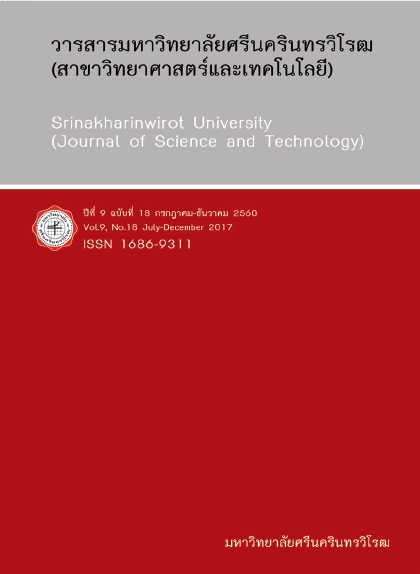ปัจจัยที่มีผลต่อกระบวนการสกัดเพคตินจากลูกตาลสุกด้วยน้ำโดยไม่ปรับพีเอช (FACTORS AFFECT PECTIN EXTRACTION PROCESS FROM RIPEN SUGAR PALM BY WATER WITHOUT PH ADJUSTING)
Abstract
In this research, pectin was extracted from ripe Palmyra palm pulp which contained low methoxyl pectin. The purposes of this research was to develop pectin extraction method without alteration of the extraction temperature and pH. The effect of water ratio, pH, and temperature on the yield and quality characteristics of pectin were investigated. It was found that the water ratio used in the extraction 1:3, 1:5, 1:7, 1:9 and 1:11 (ripen sugar palm : water) did not significant affect the yield of pectin extracted (P>0.05). The results showed that the extraction condition of unadjusted pH at room temperature gave highest pectin yield (25.96 ± 1.75 %). The pectin from a condition of unadjusted pH at room temperature and the pectin from conventional method were analyzed and then compared. The properties of pectin including moisture content, ash content and galacturonic acid content was non - significantly different (P>0.05). The pectin from both methods was categorized as low methoxy pectin even though the result of degree of esterification and methoxyl content showed significant difference (P≤0.05). The results suggested that pectin from ripe Palmyra palm can be extracted successfully by water at room temperature.
Downloads
References
[2] Thakur, B. R. (1997). Chemistry and uses of pectin. Critical Reviews in Food Science and Nutrition.
37(1): 47–73.
[3] กิตติพงษ์ ห่วงรักษ์. (2536). ผักและผลไม้. กรุงเทพฯ: ภาควิชาอุตสาหกรรมเกษตร คณะวิทยาศาสตร์การอาหาร
สถาบันเทคโนโลยีพระจอมเกล้าเจ้าคุณทหารลาดกระบัง.
[4] ชวนิฏฐ์ สิทธิดิล; กรัตน์พิลาณี ไวถนอมสัตย์; จิราพร เชื้อกูล; และ ปริศนา สิริอาชา. (2548). การผลิตเพคตินจาก
เปลือกและกากส้มเหลือทิ้ง. ใน การประชุมทางวิชาการของมหาวิทยาลัยเกษตรศาสตร์ ครั้งที่ 43. หน้า
469-480. กรุงเทพฯ: มหาวิทยาลัยเกษตรศาสตร์.
[5] ณรงค์ ศิริรัมย์; และ เมธินี เห่วซึ่งเจริญ. (2548). การสกัดและสมบัติของเพคตินจากกากฝรั่งพันธ์กลมสาลี่.
วิทยานิพนธ์วิทยาศาสตร์มหาบัณฑิตวิทยาศาสตร์และเทคโนโลยีการอาหาร. เชียงใหม่: คณะอุตสาหกรรม
เกษตร มหาวิทยาลัยเชียงใหม่.
[6] ปาริฉัตร หยวกแฟง; นฤมล เผือกขาว; และ อรนาถ สุนทรวัฒน์. (2550). การหา degree of methyl esterification
ของเพคตินจากเปลือกแก้วมังกร. วารสารวิทยาศาสตร์เกษตร. 38:5(พิเศษ): 55-58.
[7] กนกพร สังขรักษ์; และ เจนจิรา โตะแบ. (2552). เพคตินจากเศษผักกาดขาวและการประยุกต์ใช้. ใน การประชุม
วิชาการและเสนอผลงานวิจัย มหาวิทยาลัยทักษิณ ครั้งที่ 19 ประจำปี 2552: การวิจัยและพัฒนาเพื่อความ
เป็นไทสำหรับสังคมไทย. หน้า 233-234. สงขลา: มหาวิทยาลัยทักษิณ.
[8] สมฤทัย จิตภักดีบดินทร์; และ อมราวดี จางวาง .(2552). เพคตินจากเปลือกมะนาว. วิทยานิพนธ์วิทยาศาสตร์
มหาบัณฑิต. ปัตตานี: ภาควิชาเทคโนโลยีเภสัชกรรม คณะเภสัชศาสตร์ มหาวิทยาลัยสงขลานครินทร์.
[9] Rungrodnimitchai S. (2011). Novel source of pectin from young sugar palm by microwave assisted
extraction. Procedia Food Science. (1): 1553-1559.
[10] สุธิดา ทองคำ. (2552). การสกัดเพคตินจากจาวตาลและเมล็ดตาลอ่อน. วารสารวิทยาศาสตร์แห่งมหาวิทยาลัย
ราชภัฏเพชรบุรี. 8(1): 45-51.
[11] สุธิดา ทองคำ; และ พูนศิริ ทิพย์เนตร. (2555). การสกัดเพคตินจากจาวตาล. วารสารวิทยาศาสตร์แห่ง
มหาวิทยาลัยราชภัฏเพชรบุรี. 9(1): 3-11.
[12] ศิวะเทพ เรืองพรหม; และ กิตติชัย บรรจง. (2557). การเปรียบเทียบคุณลักษณะและผลผลิตของเพกตินจาก
เปลือกตาลดิบที่ใช้แอลกอฮอล์นำกลับมาใช้ใหม่ทดแทนเอธิลแอลกอฮอล์ 95% ในขั้นตอนการตกตะกอน
และการล้าง. วารสารเกษตรพระจอมเกล้า. 32(1): 50-58.
[13] Whister, R. L.; and BeMiller, J. N. (1973). Industrial gums: polysaccharides and their derivatives. New
York: Elsevier.
[14] มนัสนันท์ บุญทราพงษ์; กมลวรรณ แจ้งชัด; อนุวัตร แจ้งชัด; และ วิชัย หฤทัยธนาสันติ์. (2544). การศึกษา
คุณภาพของเนื้อตาลสุกและขนมตาลที่ผลิตจากเนื้อตาลสุกผ่านกระบวนการพาสเจอไรเซชัน. ใน การ
ประชุมทางวิชาการของมหาวิทยาลัยเกษตรศาสตร์ ครั้งที่ 39. หน้า 425-433. กรุงเทพฯ:
มหาวิทยาลัยเกษตรศาสตร์.
[15] ณัฐนรี ใยเทศ; และ พรรษา เศษบุบผา. (2558). การสกัดเพคตินจากเนื้อลูกตาลสุกด้วยน้ำโดยไม่ปรับพีเอช.
สาขาวิศวกรรมแปรรูปอาหาร. กรุงเทพฯ: คณะอุตสาหกรรมเกษตร สถาบันเทคโนโลยีพระจอมเกล้าเจ้าคุณ
ทหารลาดกระบัง.
[16] AOAC. (2000). Official Methods of Analysis Association of Official Analytical Chemists. 17th Volume I.
USA.
[17] Ranganna, S. (1997). Manual of analysis of fruit and vegetable product. New Delhi: McGraw-Hill.
[18] Kulkarni, S. G.; and Vijayanand, P. (2010). Effect of extraction conditions on the quality characteristics
of pectin from passion fruit peel (Passiflora edulis f. flavicarpa L.). LWT-Food Science and
Technology. 43(7): 1026-1031.
[19] Massiot, P.; Rouau, X.; and Thibault, J. F. (1988). Isolation and characterisation of the cell-wall fibres
of carrot. Carbohydrate research. 172(2): 217-227.
[20] Voragen, A. G. J.; Pilnik, W.; Thibault, J.-F.; Axelos, M. A.; and Renard, C. M. G. C. (1995). Pectins. In
A. M. Stephen (Ed.). Food polysaccharides and their applications. pp. 287-340. New York: Marcel
Dekker.
[21] Assoi, S.; Konan, K.; Walker, L. T.; Holser, R.; Agbo, G. N.; Dodo, H.; and Wicker, L. (2014).
Functionality and yield of pectin extracted from Palmyra palm (Borassus aethiopum Mart) fruit.
LWT-Food Science and Technology. 58(1): 214-221.
[22] Methacanon, P.; Krongsin, J.; and Gamonpilas, C. (2014). Pomelo (Citrus maxima) pectin: Effects of
extraction parameters and its properties. Food Hydrocolloids. 35: 383-391.
[23] Muhamadzadeh, J.; Sadegi-Mahoonak A.R.; Yaghbani, M.; and Alami, M. (2010). Extraction of pectin
from Sunflower Head Residues of Selected Iranian Caltivars. Word Applied Science Journal. 8: 21-
24.
Downloads
Published
How to Cite
Issue
Section
License
Srinakharinwirot University Journal of Sciences and Technology is licensed Under a Creative Commons Attribution-NonCommercial-NoDerivs 4.0 International (CC-BY-NC-ND 4.0) License, Unless Otherwise Stated. Please Read Journal Policies Page for More Information on Open Access, Copyright and Permissions.



